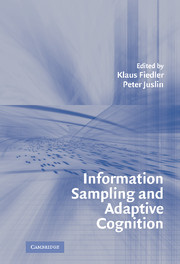Book contents
- Frontmatter
- Contents
- List of Contributors
- PART I INTRODUCTION
- PART II THE PSYCHOLOGICAL LAW OF LARGE NUMBERS
- 2 Good Sampling, Distorted Views: The Perception of Variability
- 3 Intuitive Judgments about Sample Size
- 4 The Role of Information Sampling in Risky Choice
- 5 Less Is More in Covariation Detection – Or Is It?
- PART III BIASED AND UNBIASED JUDGMENTS FROM BIASED SAMPLES
- PART IV WHAT INFORMATION CONTENTS ARE SAMPLED?
- PART V VICISSITUDES OF SAMPLING IN THE RESEARCHER'S MIND AND METHOD
- Index
- References
4 - The Role of Information Sampling in Risky Choice
Published online by Cambridge University Press: 02 February 2010
- Frontmatter
- Contents
- List of Contributors
- PART I INTRODUCTION
- PART II THE PSYCHOLOGICAL LAW OF LARGE NUMBERS
- 2 Good Sampling, Distorted Views: The Perception of Variability
- 3 Intuitive Judgments about Sample Size
- 4 The Role of Information Sampling in Risky Choice
- 5 Less Is More in Covariation Detection – Or Is It?
- PART III BIASED AND UNBIASED JUDGMENTS FROM BIASED SAMPLES
- PART IV WHAT INFORMATION CONTENTS ARE SAMPLED?
- PART V VICISSITUDES OF SAMPLING IN THE RESEARCHER'S MIND AND METHOD
- Index
- References
Summary
Life is a gamble. True to the cliché, we can rarely be certain of the consequences of our everyday actions. Presumably because of life's lack of certainty, much of the psychological research on decision making under risk is devoted to the study of choices between monetary gambles or prospects. With few exceptions, the outcomes and outcome probabilities of such gambles are explicitly described to the decision maker before he or she makes a choice. How often are life's gambles described in this way? When we decide whether to back up our computer's hard drive, cross a busy street, or go out on a date, we often do not know the complete range of the possible outcomes, let alone their probabilities. Yet we routinely make such decisions, usually without difficulty. We do so by drawing upon our experience with the relevant prospects, for instance, by recalling the outcomes of previous choices. Though effective, sampling from experience brings with it the potential to generate a skewed picture of the risky prospects we face. As we will argue here, this potential is greatest when the outcome probabilities are small and relatively few outcomes have been experienced by the decision maker. Under these circumstances, decisions derived from experience are likely to be systematically different from those made in full knowledge of the outcomes and outcome probabilities.
In this chapter, we investigate risky decisions made on the basis of sampled experience. Three findings deserve emphasis.
- Type
- Chapter
- Information
- Information Sampling and Adaptive Cognition , pp. 72 - 91Publisher: Cambridge University PressPrint publication year: 2005
References
- 5
- Cited by



